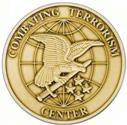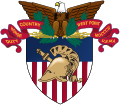Combating Terrorism Center
 | |
| Established | 20 February 2003 |
|---|---|
| Location |
|
Chair | Amb. Dell Dailey |
Director | LTC(P) Sean Morrow |
| Affiliations | United States Military Academy |
| Website | ctc |
The Combating Terrorism Center is an academic institution at the
History
At the time of the attacks on the United States on
Research and analysis products
In addition to providing counterterrorism education, the CTC also regularly publishes a wide range of analyses and reports in its subject-specialty areas. Some of the most significant and large-scale of these research and analysis products are detailed below.
The Militant Ideology Atlas[6] used citation analysis to provide the first systematic mapping of the ideologues most influential in the global jihadi movement.[7] Analyzing the most downloaded jihadi literature from one of al-Qa'ida's online libraries and cataloging more than 11,000 citations from these texts, the Militant Ideology Atlas found that the most influential living jihadi thinkers are not – as is commonly supposed – senior leaders of al-Qa'ida itself, but rather a handful of primarily Saudi and Jordanian clerics; the most widely cited writer is the Palestinian-Jordanian Abu Muhammad al-Maqdisi.[8] The Atlas was published in November 2006.
Harmony Database Reports are works of analysis and policy recommendation produced by the CTC on the basis of documents declassified for this purpose by the
Islamic Imagery Project published the first complete catalog of important, recurring images used in violent jihadi propaganda with explanations to enhance the understanding for students, teachers, and policy makers.[14]
CTC Sentinel
CTC Sentinel is a monthly, interdisciplinary journal that covers research and news.[15] The Atlantic describes it as "a leading practitioner-oriented journal on terrorism and counterterrorism issues."[16]
Notes
- ^ "History". Combating Terrorism Center at West Point. Archived from the original on 27 September 2023. Retrieved 27 February 2019.
- ^ "Yesterday's Developments at a Glance," The San Diego Union-Tribune, 21 February 2003
- ^ "Jihadi Ideology is Spreading Online". Archived from the original on 6 May 2007. Retrieved 24 May 2007.
- ^ "CTC Semiannual Report, Summer-Fall 2006" (PDF). Retrieved 22 May 2007. [dead link]
- ^ "CTC welcomes new director". Archived from the original on 26 May 2022. Retrieved 26 May 2022.
- ^ "Militant Ideology Atlas" (PDF). Archived (PDF) from the original on 28 July 2011. Retrieved 5 August 2007.
- ^ Mazzetti, Mark (15 November 2006). "Qaeda Leaders Losing Sway Over Militants, Study Finds". The New York Times. Archived from the original on 25 April 2023. Retrieved 23 June 2007.
- ^ "Militant Ideology Atlas, Executive Report" (PDF). Archived from the original (PDF) on 30 June 2007. Retrieved 23 June 2007.
- ^ Diamond, John (16 February 2006). "Al-Qaeda documents show inner struggles, strategies". USA Today. Archived from the original on 28 December 2011. Retrieved 21 May 2007.
- ^ "Harmony and Disharmony: Exploiting al-Qa'ida's Organizational Vulnerabilities". Archived from the original on 8 June 2007. Retrieved 23 June 2007.
- ^ "Al-Qa'ida's (Mis)Adventures in the Horn of Africa". Combating Terrorism Center at West Point. 9 March 1993. Archived from the original on 13 May 2011. Retrieved 2 February 2013.
- ^ http://www.ctc.usma.edu/wp-content/uploads/2010/06/Al-Qaidas-MisAdventures-in-the-Horn-of-Africa.pdf Archived 28 July 2011 at the Wayback Machine [bare URL PDF]
- ^ "Cracks in the Foundation". Combating Terrorism Center at West Point. 11 September 2001. Archived from the original on 11 June 2011. Retrieved 2 February 2013.
- ^ "Motifs in Jihadi Internet Propaganda" (PDF). ctc.usma.edu. 2006. Archived from the original (PDF) on 15 April 2010. Retrieved 28 February 2010.
- ^ "CTC Sentinel". Combating Terrorism Center at West Point. Archived from the original on 15 May 2011. Retrieved 2 February 2013.
- ^ Cottee, Simon (8 September 2017). "The Myth of the ISIS Female Suicide Bomber". The Atlantic. Archived from the original on 2 June 2022. Retrieved 17 October 2017.

